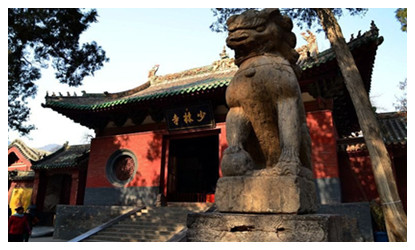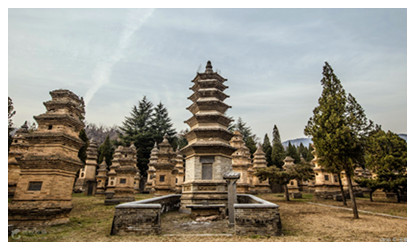Skype: neodalle-travel
Tel: +86 135 7447 2266
E-mail: sales@zhangjiajieholiday.com
Shaolin Temple is located in the region of Songshan Mountain, Dengfeng City, Henan Province.Reputed to be 'the Number One Temple under Heaven', Shaolin Temple is the must-see place if you create China Kung Fu Tour. Included on UNESCO's World Cultural & Natural Heritage List in 2010, it is the cradle of the Chinese Zen Buddhism and the Shaolin Martial Arts such as Shaolin Cudgel.
 The Shaolin Temple has many legends and mysteries surround it. The origin of martial arts and the origin of Kung Fu surround the vague mysteries of the Shaolin Temple and the Shaolin Monks.
The Shaolin Temple has many legends and mysteries surround it. The origin of martial arts and the origin of Kung Fu surround the vague mysteries of the Shaolin Temple and the Shaolin Monks.
Shaolin Temple was established in AD 495 by Emperor Xiaowen in order to receipt the Indian monks. Batuo, an Indian monk, came to Luoyang, the ancient capital, for spreading Buddhism at that period. Emperor Xiaowen was a believer of Buddhism so he decided to build the temple in the Songshan Mountains to house Batuo, who translated many Buddhist works and had a few hundred followers there.
Shaolin Temple is well-known for its Zen and Wushu. It has been made great reputation in Sui and Tang Dynasty; In Song Dynasty, the Shaolin Wushu has come into being a unique system, called “Shaolin Faction” and until Ming Dynasty, Shaolin Temple has held over 2,000 monks at its peak, being a world famous Buddha Temple. But martial arts were forbidden during the Qing Dynasty (1644-1911). Even with the protection of solder-monks, Shaolin was severely damaged by fire a few times. The largest fire set by the army of Shi Yousan in 1928 destroyed most of the buildings of Shaolin Temple.
What to see ?
There are many noted relics at Shaolin. There are over 300 ancient stone inscriptions, some of them by famous calligraphers. The large mural of 500 arhats in the Qianfo Hall was from the Ming Dynasty. There are 232 pagodas from different dynasties, known as the forest of pagodas. The oldest one was from the Tang Dynasty. The pagodas are the tombs of the celebrated Shaolin monks. The Shaolin martial arts are an important part of the relics.
The Shanmen Hall
Hung on its top is a tablet reading 'Shaolin Temple'. The tablet was inscribed by the Emperor Kangxi (1622 - 1723) during the Qing Dynasty (1644 - 1911). Under the stairs of the hall crouches two stone lions made in the Ming Dynasty (1368-1644). The hall enshrines the Maitreya Buddha. Two sides of the corridor behind the hall's gate are paved with inscriptions on stone steles made during several different dynasties.
The Heavenly Kings Hall
The gate of the hall is guarded by two figures depicting Vajra (Buddhist warrior attendants). Inside the hall are figures of the Four Heavenly Kings who are responsible for inspecting peoples' behavior, helping the troubled, and blessing the people.
The Mahavira Hall
The complex's center is right before your eyes. Both important celebrations and regular prayers are held here. 18 Buddhist Arhats stand along the eastern and the southern walls of the hall. Buddhas of the Middle, East and West are enshrined in this hall, respectively Sakyamuni Buddha, Pharmacist Buddha and Amitabha Buddha. Figures of Kingnaro (the founder of Shaolin Cudgel) and Dharma (the founder of Chinese Zen Buddhism) stand beside those three Buddhas, a placement which is very different from other Mahavira Halls. At the feet of the pillars in this Mahavira Hall are stone lions that are more than one meter (about 3.33 feet) high. On the ground there are about 50 small pits, 20 centimeters (about 7.87 inches) deep. It is said that they are the footprints left by monks when they practiced Shaolin Martial Arts.
The Pagoda Forest
 It is a graveyard for Buddhist dignitaries through the ages. On average, the pagodas are less than 15 meters (about 49 feet) high. The layer and the shape of a pagoda depend on many factors, such as one's Buddhist status, attainment and prestige during his lifetime. The Pagoda Forest here is the largest of China's pagoda complexes.
It is a graveyard for Buddhist dignitaries through the ages. On average, the pagodas are less than 15 meters (about 49 feet) high. The layer and the shape of a pagoda depend on many factors, such as one's Buddhist status, attainment and prestige during his lifetime. The Pagoda Forest here is the largest of China's pagoda complexes.
The Ancestor's Monastery
Outside the Shaolin Temple, there are two Ancestor's Monasteries.The first monastery is built by a Dharma's disciple to commemorate Dharma's nine years of meditation in a cave. It has a big hall supported by 16 stone pillars on whose shafts are exquisitely carved warriors, dancing dragons and phoenixes.The Second Ancestor's Monastery is a nursing home of the second ancestor Huike who cut his left arm in order to show his sincerity to study Buddhism from Dharma. In front of the monastery are four springs created by Dharma to help Huike to fetch water easily. They are called 'Spring Zhuoxi' and each has its own distinctive flavor.
The Dharma Cave
In this cave Dharma patiently faced the wall and meditated for 9 years. Finally, he reached the immortal spiritual state and created the Buddhist Zen. The cave is seven meters deep (about 23 feet) and three meters high (about 9.8 feet). Many stone inscriptions are carved on both its sides. There is a Meditating Stone in the cave. It is said Dharma's shadow was reflected upon the stone and embedded on it because of the long time of his meditation facing the wall. Unfortunately the stone was ruined during the war.
The Buddhist Living Quarters
For transient monks, the Buddhist Living Quarters is on the south bank of the Shaoxi River opposite the temple. First built in 1512 of the Ming Dynasty, it was repaired in the Qing Dynasty. The quarters are noted for the simple and distinctive design. It collapsed in 1958 and then repaired in 1993.
Shaolin Temple Wushu (Martial Arts) Training Center
Its perfect scenery makes it an ideal place for practicing the Chinese Shaolin Kung Fu. Shaolin monks have been practicing Kung Fu for over 1,500 years. The system was invented by Dharma who taught the monks basic methods to improve their health and defend themselves. The Martial art performance shows the true Chinese Shaolin Kung Fu. For example, Tong Zi Gong, performed by teenagers, is a kind of martial art to train one's flexibility and strength.
Shaolin Temple is worthy of a visit. Come to Shaolin Temple,you can see wild flowers and pines on the mountain. With birds singing and a brook spattering, a beautiful scene full of life and vitality is revealed to the visitors. It will give you a better understanding of Chinese Buddhism and the Chinese martial arts.
Travel Tips
Address: South Side of Tourist Service Center, Shaolin Scenic Spot, Dengfeng City, Zhengzhou City, Henan Province
Opening hours: 08: 00-18:00
Entrance Fee: CNY 120
 Ask Questions ?
Ask Questions ?